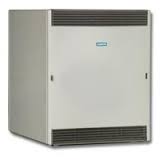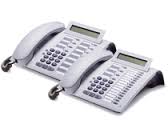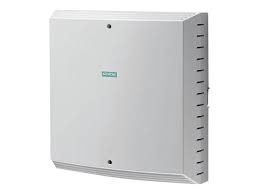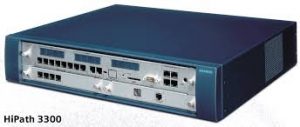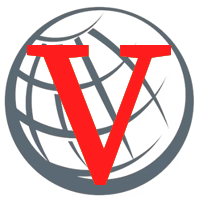HiPath 3000 HiPath 3700/3750, HiPath 3500/ 3550, HiPath 3300/3350 IP Communication Platform
For Small and Medium Enterprises HiPathTM 3000 is the multifunctional communication system for integrated voice and data solutions. Depending on the particular system variant, HiPath 3000 can be configured for up to 384 conventional voice users and 50 data terminals. Integration in an Ethernet LAN makes up to 500 workpoints with IP telephones or softclients possible. Interactive user prompting via a display and dialog keys makes it quicker and easier to activate digital system telephone features, as well as on IP telephones with the HFA protocol. Along with the HiPath Cordless Office solution, the system telephones convienient user prompting is also available on DECT feature telephones. The use of a flexible adapter concept means you can connect a wide variety of add-on devices directly to the system telephones. Individual workstations can thus keep pace with continuously changing requirements. In the case of sector concepts, networking with other systems is achieved using the performance-optimized CorNet N and QSig networking protocols, or via TCP-IP-based LAN-LAN links. A universal software concept provides a professional set of features for companies of all sizes. Individual user solutions are either integrated into the system as a module or connected via open interfaces. HiPath 3000 offers flexible migration from conventional communications systems to an IP-based multimedia communications platform. System
Family HiPath 3000 is made available for various installation scenarios
● Floor standing System HiPath 3750
● Wall-Mounted System HiPath 3550 / 3350
● 19″ Rack-Mounted HiPath 3700 / 3500 / 3300 19″ Variants On the 19″ model variant HiPath 3700, a patch panel is used for connecting peripherals. The 19″ model variants HiPath 3500/3300 are designed for RJ-45 technology. Peripherals for this model are connected directly. HiPath 3700 HiPath 3750 HiPath 3500 HiPath 3550 HiPath 3300 HiPath 3350 System features The HiPath 3000 system offers a wide range of features. Selected features
● Caller list. Unanswered internal and external calls are recorded on system telephones with a display if external calls contain a directory number (ISDN) and internal calls are transmitted with the caller’s name. The calls are entered in a list with a date and time stamp and the number of call attempts is recorded. A callback can be initiated directly from this list.
● Do-not-disturb/”silent call”. Users can block incoming calls. Callers hear the busy signal when “do-not-disturb” has been activated. Authorized users (attendants, for example) can override this feature. Acoustic signaling of calls can be deactivated on system telephones so they are only indicated on the display (not available on optiset E / optiPoint 500 entry).
● Call pickup. Calls can be picked up on users’ own telephones within a call pickup group or selectively for specific colleagues.
● Override. Authorized stations can intrude on other users’ calls in progress.
● Classes-of-service Different access authorizations can be assigned to each PBX user, with a distinction being made between: – unrestricted toll access – outward restricted toll access – no toll access
● Broadcast intercom call to system telephones or over external loudspeakers (in a waiting room, for instance) ● Call cost logging for each terminal or each trunk in the summation memory. Call duration display is used for lines without call charge pulses.
● Group call for a total of 150 groups with max. 20 users. Individual stations can temporarily leave the group.
● Line keys (MULAP) The following flexible setups are possible with line keys: – teams, – executive/secretary functions, – feature handset (gigaset) in parallel with an system telephone on a single directory number (only in conjunction with HiPath Cordless Office).
● Internal telephone book. All extensions are stored with their associated names in the system’s internal telephone book. They can be searched and dialed directly via the display on system telephones.
● Speed dialing individual/system. For all services it is possible to store up to 10 destinations on each telephone individually and up to 1,000 destinations centrally in the system. ● Toggling between two existing connections.
● Text messages. You can send users predefined (e.g. “Visitor waiting”) or personal short messages (optiset E memory only) via the display.
● Internal texts to the feature handset. When HiPath cordless is used it is also possible to send internal text messages to the feature handset.
● Advisory messages can be left on your own telephone (e.g. Back at:….). ● Project code. Telephone costs can be assigned to a specific procedure or project by entering the project code (max. 11 digits). This can also be done while a call is in progress.
● Call number suppression. With ISDN connections, callers can suppress the display of their directory number on the called party’s terminal either on a crosssystem basis or temporarily.
● Distinctive call signaling for internal calls, external calls, recalls, and callback calls. ● Add-on ringing. Call signaling simultaneously at several telephones.
● Switches (actuators /sensors). Via a control relay module it is possible to connect up to four free relays that can be accessed via codes (optional). (no sensors on the HiPath 3700/3750)
● Door interface. For entrance telephone and door opener functions. Calls from the entrance telephone can even be routed to an external destination by using external call forwarding
● Automatic redial (expanded) for the last three external call numbers dialed. Standard features
● Intercept position/attendant console
● Camp-on/call waiting tone
● Call forwarding from the extension ● Display languages (can be specified individually)
● Conference (internal/external) ● Line seizure (automatic)
● Music on hold
● external music source (optional)
● Night service/day service ● Parking ● Consultation
● Callback on busy and no answer (automatic)
● Call forwarding – no answer after timeout
● Hunt group (linear/cyclic)
● Lock telephone (individual code lock)
● Telephone book, central
● Transferring a call (internal/external)
● Recall Euro-ISDN features The prerequisites for a pan-European, uniform communication structure have been met by the DSS1 Euro-ISDN standard. This allows the cross-country use of services and features which are also supported by HiPath 3000. The following Euro-ISDN functions are supported: Services. Voice and group 3 fax are transmitted on a 3.1 kHz bandwidth; data and group 4 fax are transmitted at 64kbit/s per B-channel. Direct dialing in (DDI). This feature allows direct dialing in from the public exchange to any individual PBX station. Calling line identification presentation (CLIP). The caller’s ISDN directory number is transmitted to the called party. Calling line identification restriction (CLIR). The caller’s directory number is not transmitted to the called party. This feature can be initiated by the dialing party on a cross-system basis or temporarily using a procedure. Connected line identification presentation (COLP). The called party’s directory number is displayed to the caller. Connected line identification restriction (COLR). Display of the called party’s directory number to the caller is prevented. Multiple subscriber numbers (MSN). Users connected to an S0 bus can be assigned individual call numbers (MSNs) from the PBX’s numbering scheme via which they can be directly addressed (e.g. PC cards, group 4 fax). Advice of charge (AOC). Call charge information is transmitted to the PBX during or after the call. This information can be shown on the station display in units or currency amounts. The AOC-S feature allows information on the expected charges to be displayed before the start of a call. Sub-addressing (SUB). Information additional to the directory number is transmitted to the dialed distant station. This can be used to trigger certain procedures. A response is not possible. User-to-user signaling (USS1). User-touser signaling allows a limited volume of information to be transferred in both directions from one terminal to another via the signaling channel. Call forwarding in the public network (CFU, CFB, CFNR) (not available with S2M). All calls intended for an ISDN line are forwarded to any destination. This feature is activated from an authorized telephone and applies to the entire connection in the case of a DDI call (point-to-point). In the case of a point-to-multipoint connection only the MSN assigned to the telephone is forwarded. Call deflection (CD). Calls for an internal user who has activated external call forwarding are deflected via the public exchange to the external destination station. The Bchannels are thus not required and are released. In the present version, call charges are not registered at the PBX. Callback in the public network (CCBS). If an external called party is busy it is possible to store a callback request in the public network. The initiating party is called back when the party is free. Malicious caller identification (MCID). With this feature, malicious callers can be identified in the public network. Use of this feature must be requested from the public carrier. Attendant consoles optiPoint Attendant An optiset E memory system telephone can be used as an attendant console. This allows outside calls to be extended if the direct dialing in (DDI) function has been set up. In DDI mode, this position can be organized as an information, intercept, or night service station. You can make use of special features in addition to the conventional telephone functions. These are:
● night service
● telephone book
● number of queued calls (can be set up on up to six telephones in the system)
● enabling for call waiting
● hold
● call key 1
● call key 2
● release In addition, a key can be set up with the “error key” feature. The attendant console can be accessed internally via a second directory number. It is possible to extend undialed lines and calls on hold. If the number of users on hold reaches a preset level, calls will be forwarded to a specified destination. This will also take place when the length of time a call is queued exceeds a specified limit. Operation is also possible without an attendant console. In such cases, the user assigned in each case to one line will be regarded as the attendant. optiClient Attendant This software package simulates a comfortable attendant console on your PC’s screen. All attendant features can be activated and executed via the PC keyboard and mouse. optiPoint BLF The busy lamp panel (BLF) is an additional module principally for optiPoint Attendant. It has ninety LEDs and freely programmable function keys. The individual LEDs are assigned on the telephone or via HiPath 3000 Manager C / E. The status of the users is displayed (free, busy, called). Braille console Optical displays are translated into Braille by an add-on device connected to the PC. This enables visually impaired employees to perform all call-extending tasks. Executive/secretary features These features ensure rapid communication between executives and secretaries.
● Camp-on at an executive’s phone by the secretary’s phone
● Secretarial function transfer
● Call transfer to the secretary’s phone
● DSS keys for executive/secretary
● Conference corner telephone with parallel call signaling to the executive’s phone
● A private line can be set up for either the executive or secretary Inclusion of the gigaset feature handset for mobile accessibility. System administration System administration by the customer can be carried out either on the telephone or using HiPath 3000 Manager C. The feature Attendant TC allows customers to perform administration tasks on an system telephone with a display. The optiset E memory telephone is recommended, as this has an alphanumeric keypad (e.g for entering station names etc.). HiPath 3000 Manager C is a customer tool that runs under Microsoft® Windows and is installed on the PC connected to the system via a V.24, S 0 or TCP-IP-based LAN interface. The service technicians have other PCbased service tools to assist them in completely installing the communication system and for comprehensive administrative functions; they can also make changes and settings on the communication system using remote maintenance. Customer data is always guaranteed maximum protection in accordance with applicable data protection legislation. The communication systems can be incorporated in Ethernet LANs by means of a LAN interface. Data is exchanged using SNMP (Simple Network Management Protocol). The following functions are supported:
● System administration
● Fault management
● System software updating Relocate This feature allows system telephones to be plugged in at another location without the need for subsequent interventions in the system administration. A relocated terminal retains its existing extension number and user features. This ensures that all users involved are available again as quickly as possible following relocation (e.g. project groups). Data protection/data security To protect the communication system and customer data from unauthorized access, the Service menu can only be entered by means of individual user IDs. This means it is possible at all times to establish who carried out what system modifications and when. System administration is structured as follows:
● User data: Access via the Service menu using an individual user ID and password to protect customer data such as speed dialing destinations and call charge data. Communication system owners can make minor system settings with a defined scope themselves.
● System data: Access via the Service menu using a user ID for system administration and password. Access to this data area is restricted to qualified personnel and is password-protected.
● Password concept with individual identification and authentication.
● System access via telephone or service tool and remote access is controlled. Administrative procedures can be logged. (“Who made changes, and when“) User solutions Mobile communication HiPath Cordless Office An integratable solution based on the DECT standard for full-coverage availability throughout the company premises using cordless phones. Voice server HiPath Xpressions Compact This is an adaptable speech memory system for deferred and location-independent storage, retrieval, and distribution of voice messages in users’ own individual voice mailboxes. Automatic Call Distribution (ACD) HiPath ProCenter Office A call center solution that distributes incoming calls automatically and evenly to specific groups of agents. Statistical evaluation using a convenient graphical presentation provides the basis for efficient personnel planning. Computer Telephony Integration (CTI) HiPath TAPI 120 / 170 The driver software was developed as a supplement for connecting a PC to digital system telephones on HiPath. Support is provided for TAPI-conform CTI applications. Smartset This software for making calls from the PC records both incoming internal and external (ISDN) calls in a caller list. Comparing this number to numbers stored in the PC’s address book identifies the ISDN caller. DP programs can also be initialized on incoming ISDN calls. Data applications HiPath HG 1500 With HiPath HG 1500, connection of the HiPath 3000 communication platform is made via an ethernet-based LAN. HiPath HG 1500 turns your HiPath system into a hub for voice, data, and video communication and meets all requirements applying to low and medium-level data traffic. Multimedia applications To bring managers and teams closer together, a variety of multimedia applications can be combined with HiPath 3000 to form a convenient video conference system. Applications from various manufacturers are available for this. Call charge management TeleData Office TeleData Office is a PC-based software program for recording and assigning incoming and outgoing call charge data that permit evaluation by extension, trunk, department etc. The call charge data can be transmitted directly to a central server via the LAN interface. Branch solutions HiPath 3000 in hotels HiPath Hotel Entry HiPath Hotel Entry is an economical communication solution for small and mediumsized hotels that operate without DP- or PCbased hotel solutions Fast and reliable handling via the Memory Desk reception terminal caters for all major functions involved in the day-to-day running of a hotel, ensuring even greater efficiency in making the guests’ stay a pleasant one (HiPath 3500/3550 models only). Caracas Inn This Windows-based PC software package meets the requirements of medium-sized hotels such as check-in/check-out, call charge billing, and wake-up service. HiPath Hotel Advanced A standardized hotel interface ensuring the reliable connection of convenient Front Office solutions to HiPath 3000. Least Cost Routing HiPath 3000 uses this function to automatically control the path used for an outgoing call. Calls can be routed via the public network or various carriers or a private network. The most favorable connection path for the external call is found using the routing tables. A trunk is seized after reference to the routing tables. These analyze the digits dialed by the user and determine the directory number to be dialed by the system. Individual network providers in many cases offer different charge rates for certain connections and conditions, so with Least Cost Routing it is possible to automatically select the most economical connection for each outgoing telephone call depending on the time of day and route. Networking Our local sales units will be able to provide you with details of the features that are possible in the type of networking concerned and the relevant networking protocol. Digital nailed connections Corporate communication networks can be implemented over digital S0 or S2M nailed connections between several HiPath systems using the CorNet N protocol and between HiPath and non-Siemens systems using the QSig protocol. The systems are linked with each other via public and/or private lines. Virtual network A virtual network of HiPath systems via S0 or S 2M dialup lines is advisable from an economic viewpoint in situations where nailed connections are not viable owing to low traffic levels or if the full range of services offered by a nailed connection is not required. IP Networking With HiPath 3000 it is possible to network multiple locations (nodes) via TCP/IP-based data lines. In doing so, the CorNet networking protocol is tunneled in the data flow. Telephones The following digital system telephones optiPoint 500 (2-channel UP0/E interface) are available for various workstation requirements: optiPoint 500 entry The economic telephone with open listening. optiPoint 500 economy The economic telephone with display and open listening. optiPoint 500 basic The system telephone with integrated USBinterface, display and open listening. optiPoint 500 standard The system telephone with full duplex handsfree talking, integrated USB-interface, 1 adapter port and display. optiPoint 500 advance The telephone for profis:
● background lighted display
● 2 adapter ports ● 19 function keys with LED
● integrated interface for headset ● integrated USB-interface
● full duplex handsfree talking optiPoint key module Add-on device for optiPoint 500 telephones with 16 function keys (double entries) and LED’s. optiPoint BLF Add-on device for optiPoint 500 telephones with 90 function keys and LED’s. System telephone optiset E The optiset E telephones are supported. Adapters A wide range of adapters are available offering a high level of flexibility when it comes to meeting the requirements of individual workstations. These include: optiPoint phone adapter For connecting another optiPoint 500 telephone. optiPoint ISDN adapter For connecting ISDN terminals with a nonpowered S0 interface (e.g. PC with S0 card or video equipment). optiPoint analogue adapter For connecting an analog terminal such as a group 3 fax machine, modems. optiPoint acoustic adapter For connecting a:
● active loudspeaker box
● headset
● Two contacts for busy display or door opener. optiPoint recorder adapter For connecting a recorder or a second headset. Software solutions for the USB interface CallBridge TU Software solution for CTI support over the USB interface of the optiPoint 500. CallBridge for Data Software solution for data communication over the USB interface of the optiPoint 500. System Interfaces On the trunk side Euro-ISDN
● S0 basic rate access with DSS1 protocol – System connection – Point-to-multipoint connection
● S2M primary rate access with DSS1 protocol HKZ
● Analog trunk connection without direct dialing in (DDI) On the user side Analog
● a/b for connecting analog terminals such as group 2 and 3 fax, Vtx, modem. Digital
● UP0/E for connecting digital 2-channel system telephones,
● For connecting DECT base stations Euro-ISDN ● S0 user bus for up to 8 independently powered terminal devices (e.g. group 4 fax, ISDN PC card) HiPath HG 1500
● 10/100 MBit / 10 BaseT Integration in LANs For speech/data applications Other interfaces V.24
● For connecting a service PC, call charge computer, call charge printer V.24 with CSTA protocol
● For connecting Hotel applications, care sector applications E&M interface (HiPath 3700/3750 only)
● Analog nailed connection
● Announcement before answer S0FV, S2MFV with CorNet N and QSig protocol
● Digital nailed connection TMOM board (HiPath 3700/3750 only)
● Enhanced paging equipment LAN interface
● 10 Mbit for system administration via TCP/IP Technical data Power supply Systems, by default, are designed for network operation. Possible power outages can be optionally bypassed with an uninterruptable power supply (UPS). Rated Input Voltage (AC) 88 – 264V Rated Frequency 50/60 Hz Battery Supply (DC) -48 V Environment/Operating Conditions Temperature +5 ºC to +40 ºC Relative Humidity 5 – 85% Range Between HiPath 3000 and system telephone: 500 m max. Up to approx. 1000 m. with the plug-in power supply unit, depending on line network. Between networked HiPath systems on premises belonging to the company: S0 point-to-point connection approx. 1000 m S2M nailed connection 250 m max., depending on line network. Installation of network adapters is necessary for increasing range. Ranges in Deutsche Telekom’s public net are unlimited. Technical Data Expansions HiPath 3750/HiPath 3700 (Base System / 19″ Rack) HiPath 3550 (Wall-Mounted System) Analog users (a/b) max. 256 (384*) 52 (124*) Digital users (UP0/E) max. 384 56 (80*) Additional users via optiPoint phone adapter 116 56 (80*) Maximum number of workpoints (IP telephones/softclients) 500 192 Maximum stations, HiPath Cordless Office 250 32 (64 with SLC module) Total stations TDM (including cordless) 384 max. 92 / 164* (124 / 172* with SLC module) max. Maximum number of HiPath Cordless Office base stations 64 7 / 16 with SLC module Connections to operator network 120 channels max. ISDN (S2 , S0 ), HKZ, E&M 60 channels max. ISDN (S2 , S0 ), HKZ, E&M V.24 interfaces 2 2 CSTA interface yes yes optiClient Attendant (PC attendant console) yes yes Networking yes CorNet-N QSig (ECMA V1.0, ISO) yes CorNet-N QSig (ECMA V1.0, ISO) IP networking Maximum number of nodes in the network Maximum number of stations in the network yes (CorNet-IP) 16 1000 yes (CorNet-IP) 16 1000 Number of HiPath HG 1500 Gateways 8 4 Administration via TCP/IP yes yes CTI TAPI yes yes Dimensions H x W x D (in mm) 490 x 410 x 390 450 x 460 x 200 Weight approx. 22 kg fully equipped approx. 8 kg Case color Ergo gray Warm gray Software version V3.0 (BRD / IM) * country specific Technical Data Expansions HiPath 3500 (19″ rack) HiPath 3350 (Wall-Mounted System) HiPath 3300 (19″ rack) Analog users (a/b) max. 52 20 (36*) 20 Digital users (UP0/E) max. 56 24 24 Additional users via optiPoint phone adapter 56 24 24 Maximum number of workpoints (IP telephones/softclients) 192 96 96 Maximum stations, HiPath Cordless Office 32 16 16 Total stations TDM (including cordless) 92 max. 44 (60*) 44 Maximum number of HiPath Cordless Office base stations 7 3 3 Connections to operator network 60 channels max. ISDN (S2 , S0 ), HKZ* 16 channels max. ISDN (S0 ), HKZ* 16 channels max. ISDN (S0 ), HKZ* V.24 interfaces 1 2 1 CSTA interface yes yes yes optiClient Attendant (PC attendant console) yes yes yes Networking yes CorNet-N QSig (ECMA V1.0, ISO) yes CorNet-N QSig (ECMA V1.0, ISO) yes CorNet-N QSig (ECMA V1.0, ISO) IP networking Maximum number of nodes in the network Maximum number of stations in the network yes (CorNet-IP) 16 1000 yes (CorNet-IP) 16 1000 yes (CorNet-IP) 16 1000 Number of HiPath HG 1500 Gateways 4 2 2 Administration via TCP/IP yes yes yes CTI TAPI yes yes yes Dimensions H x W x D (in mm) 155 x 440 x 380 (3,5 U) 450 x 460 x 130 89 x 440 x 380 (2 U) Weight approx. 8 kg approx. 6 kg approx. 6 kg Case color Bluegreen basic Warm gray Bluegreen basic Software version V3.0 (

